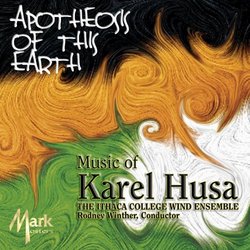A great introduction to an essential part of Husa's oeuvre
Discophage | France | 02/19/2007
(5 out of 5 stars)
"Karel Husa, probably due to his 38-year tenure at Cornell University and the presence of the house Wind band at his disposal, wrote extensively for the medium, and this double CD gathers almost half of his output in the genre. Among Husa's major compositions for the medium, his 1976 American Te Deum, his more recent "Les Couleurs fauves" (1996) and of course his famous and most often-perfomed piece "Music for Prague 1968" are here missing.
The compositions contained in these two CDs fall in two categories: those that are re-scorings of early pieces dating from his Czech and Paris years (the 1958 Divertimento for Brass and Percussion, an expansion of movements from the 1955 Eight Czech Duets, a fact not mentioned in the otherwise very informative liner notes, the 1974 Al Fresco, the 1983 Concertino for Piano and Wind Ensemble). They are marked by strong Czech and Slovak folk music elements, while the sunny Concertino (after Husa's 1949 Concertino for Piano and Orchestra) is written in an early modernist, enjoyable but rather anonymous style reminiscent of Honegger's or Schulhoff's similar compositions, despite nice twists of orchestration (which may be typical of Husa's more recent hand). It makes for pleasant but hardly memorable listening.
The only one of those re-scored pieces that transcends its origins is Al Fresco, after the 1947 Fresques (which can be found on the Marco Polo release, along with the full-orchestra version of Music for Prague and the 2nd Symphony - a good introduction to the composer's orchestral works). The wind and percussion scoring imparts it a raw energy and biting edge that blurs its folkloristic elements in favour of a more modern and angular color (sometimes you might think you were hearing the Jets and Sharks Dance in West Side Story).
The other category is that of the original compositions: the short Smetana Fanfare (1984), the Concerto for Percussion and Wind Ensemble (1970), the Concerto for Alto Saxophone and Concert Band (1967), and Apotheosis of This Earth (1971). The new works are music of great sonic invention and tremendous energy, not always very subtle in their raw power and piling up of strata of sound buttressed by heavy percussion, but hugely effective, aggressive but always accessible. Especially inventive and powerful is the percussion concerto.
A few specific words on "Apotheosis of This Earth". It was conceived as a cry of revolt and warning against Mankind's destruction of the earth and of its beauties. How lamentably still topical today! It was originally scored for Wind band with optional mixed chorus - it is here heard without, although in the last movement, as in the version with chorus, the words "this beautiful earth" can be heard, presumably pronounced by the band members. As a number of his Wind band compositions, Husa subsequently re-scored it for large orchestra (other examples are his "Music for Prague 1968"and American Te Deum). That version with chorus and orchestra can be found on CD in a composer-conducted performance with the Louisville Orchestra, first released with Husa's Monodrama and shorter pieces of Lutoslawski and Creston (I've reviewed it) and then reissued with a recording of Music for Prague by Jorge Mester. It is both more mysterious (thanks to the softer tone afforded by the strings) and more powerful (in the brutal second movement, depicting Mankind self-destructive onslaught on the planet, the worldless chorus adds a sense of ominous menace, and when it turns to screams and clapped hands at the end of the movement you can imagine Mankind being engulfed in the mouth of hell, an effect not quite achieved in the original version), but the wind version is perfectly valid in its own right. There was by the way an earlier composer-conducted recording, on a GC 4134 LP, with the University of Michigan Symphonic Winds, coupled with Music for Prague, but so far as I know it unfortunately hasn't been reissued on CD.
Stupendously vivid sound, good liner notes, but with timings of 56' and 43' there would have been enough place to fit it Music for Prague. Nonetheless, this is a great introduction to this essential part of Husa's oeuvre. Now the same band needs to record the remainder of his compositions for Winds.
"


 Track Listings (12) - Disc #1
Track Listings (12) - Disc #1